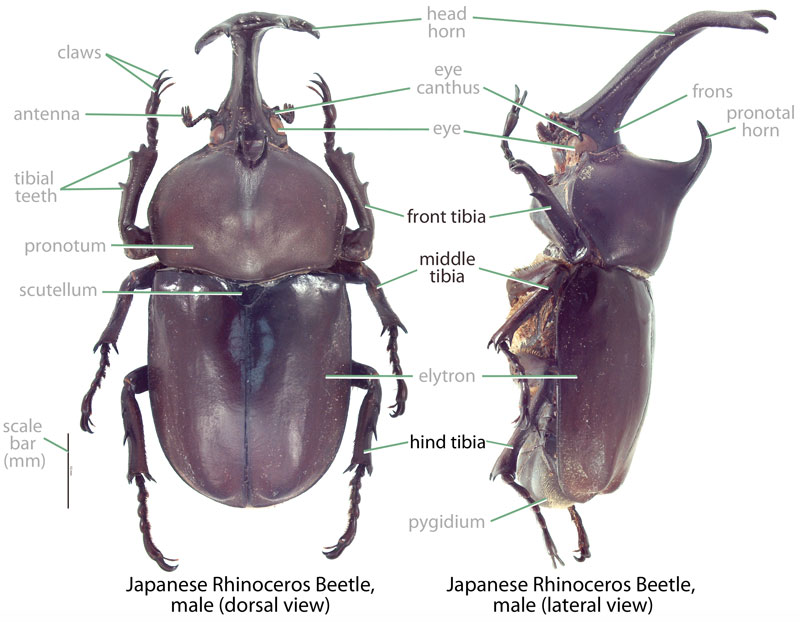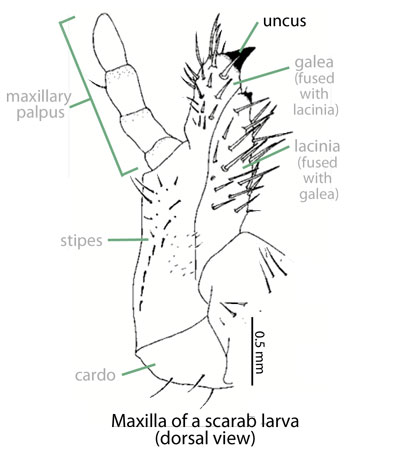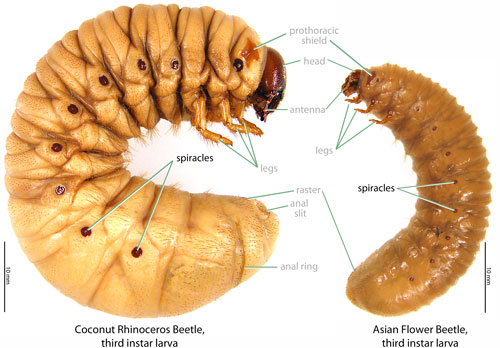USDA Regulated Pest
Philippine chafer
Family: Scarabaeidae Subfamily: Rutelinae Genus: Anomala Species: Anomala sulcatula (Burmeister, 1844)
none available
Total body length 14.0–18.0 mm (0.55–0.71 in). Body shape ovate. Color brown to nearly black; somewhat metallic. Front tibiatibia:
a segment of the leg articulated with the tarsus and femur
 with two external teeth; apical toothtooth:
with two external teeth; apical toothtooth:
a pointed process from an appendage or margin, often in reference to the tibia
longer in female than male; basal toothtooth:
a pointed process from an appendage or margin, often in reference to the tibia
feeble in male and female. Front inner claw bifurcatebifurcate:
a process dividing into two points
; bifurcatebifurcate:
a process dividing into two points
claw curved but not sinuatesinuate:
gently curved (specifically of margins or edges); often in reference to the clypeus
in either sex. Hind tibiatibia:
a segment of the leg articulated with the tarsus and femur
 of male with inner margin greatly dilated at the middle (less so in female).
of male with inner margin greatly dilated at the middle (less so in female).
Undescribed. For Anomala (Ritcher, 1966Ritcher, 1966:
Ritcher P. 1966. White grubs and their allies: a study of North American scarabaeoid larvae. Oregon State University Monographs, Studies in Entomology 4: 1-219.): Grub C-shaped, not hump-backed, cylindrical, whitish. Lacinialacinia:
inner portion of the maxilla of maxillamaxilla:
of maxillamaxilla:
set of paired mouthparts located posterior to the mandibles
with 2 apical unciunci:
in scarab larvae, a hooked process on the distal margin of the maxilla
 equal in size. Maxillary stridulatory area with 4–7 sharp, recurvedrecurved:
equal in size. Maxillary stridulatory area with 4–7 sharp, recurvedrecurved:
bending backwards
teeth. Epipharynxepipharynx:
lobe on the interior surface of the labrum or clypeus
with 2–4 prominent heliheli:
in scarab larvae, a coarse spine on or near the haptomerum
. Final antennal segment with single dorsaldorsal:
of or relating to the upper surface; opposite of ventral
sensory spot. Spiraclesspiracles:
opening on the abdomen or thorax through which air enters and exits the body
 on abdominal segments 7 and 8 similar in size and conspicuously larger than spiraclesspiracles:
on abdominal segments 7 and 8 similar in size and conspicuously larger than spiraclesspiracles:
opening on the abdomen or thorax through which air enters and exits the body
 on abdominal segments 1–6. Anal slit transversetransverse:
on abdominal segments 1–6. Anal slit transversetransverse:
extending horizontally across a surface
, arcuatearcuate:
curved, arched, or bow-shaped
; bordered by several irregular rows of stout setaesetae:
small, hair-like structure
. Lower anal lip bearing patch of 13 hamatehamate:
hook-like in shape
setae.
Philippines. This species is thought to have originated from the Philippine Islands (Suehiro, 1960Suehiro, 1960:
Suehiro A, 1960. Insects and other arthropods from Midway Atoll. Hawaiian Entomological Society 17: 289-298. full text (accessed 2015)).
Larvae are known to feed upon the roots of sugar cane (Saccharum spp.) (Pemberton, 1963Pemberton, 1963:
Pemberton C. 1963. Insect pests affecting sugar cane plantations within the Pacific, Proceedings of the 11th Congress of International Society of Sugar Cane Technologists, Mauritius. full text (accessed 2015)), rice (Oryza sativa) (International Rice Research Institute, 1986International Rice Research Institute, 1986:
Anonymous. 1986. Progress in upland rice research: Proceedings of the 1985 Jakarta conference. International Rice Research Institute, Manila, Philippines.), and corn (Zea mays) (Bryan, 1949Bryan, 1949:
Bryan E. 1949. Economic insects of Micronesia; report of the Insect Control Committee for Micronesia, 1947-1948. Washington: National Research Council, Washington DC, USA.).
Poorly known. Presumably, the life history of this species is similar to that of the closely related oriental beetle (Anomala orientalis). LarvaeLarvae:
the immature form of an insect; in scarabs, also called grub or white grub; preceded by the egg stage, followed by the pupal stage
 develop in soil where they feed upon the roots of a number of plant species. Adults are likely generalist folivores and active at night.
develop in soil where they feed upon the roots of a number of plant species. Adults are likely generalist folivores and active at night.
Moderate. This species is a USDA APHIS regulated pest (USDA APHIS, 2012USDA APHIS, 2012:
Anonymous. 2012. 2012 Prioritized Offshore Pest List. USDA APHIS. full text (accessed 2015)) and is a species of concern in California (Cosner, 2013Cosner, 2013:
Cosner C. 2013. Invasive species pathway risk analysis for California. PhD dissertation, University of California, Davis, California. full text (accessed 2015)). LarvaeLarvae:
the immature form of an insect; in scarabs, also called grub or white grub; preceded by the egg stage, followed by the pupal stage
 attack the roots of several important grass crops and are minor pests in the Philippines, Guam, and the Northern Marianas (Pemberton, 1963Pemberton, 1963:
attack the roots of several important grass crops and are minor pests in the Philippines, Guam, and the Northern Marianas (Pemberton, 1963Pemberton, 1963:
Pemberton C. 1963. Insect pests affecting sugar cane plantations within the Pacific, Proceedings of the 11th Congress of International Society of Sugar Cane Technologists, Mauritius. full text (accessed 2015)).
Recorded, not established. In 1955-56 this species was detected on a plane flying into Hawaii from Japan (USDA, 1957USDA, 1957:
Anonymous. 1957. List of intercepted plant pests, 1956 (pests recorded from July 1, 1955, through June 30, 1956). United States Department of Agriculture, Plant Quarantine Division. Hyattsville, Maryland, USA). Although not established on the main Hawaiian Islands, Anomala sulcatula was previously detected on Midway (Suehiro, 1960Suehiro, 1960:
Suehiro A, 1960. Insects and other arthropods from Midway Atoll. Hawaiian Entomological Society 17: 289-298. full text (accessed 2015)), but no recent records are known.
Established. Anomala sulcatula has been established in Guam since at least 1948 (Krombein, 1949Krombein, 1949:
Krombein, K. 1949. The aculeate Hymenoptera of Micronesia I. Scoliidae, Mutillidae, Pompilidae, and Sphecidae. Proceedings of the Hawaiian Entomological Society 13: 367-410. full text (accessed 2015)).
Having already spread to Guam, this species has a high likelihood of reaching Hawaii in the near future. Florida and the U.S. Caribbean territories are also potentially at risk. It is unclear if Anomala sulcatula could survive the cool winters in California, Texas, and the southern U.S. This species is attracted to lights at night, and it is likely that it would be attracted to well-lit ports and airports. This would allow for hitchhiking on marine or air cargo, as occurred with the 1956-57 specimen. Further, it is possible that larvaelarvae:
the immature form of an insect; in scarabs, also called grub or white grub; preceded by the egg stage, followed by the pupal stage
 or eggs could be transported in shipments of commercial turf.
or eggs could be transported in shipments of commercial turf.
Anomala sulcatula is one of five Anomala species recorded from Hawaii and Guam along with Anomala orientalis, Anomala cuprea, Anomala viridana, and Anomala albopilosa. It is separated from the other species by examination of the bifurcatebifurcate:
a process dividing into two points
male front claw (which is curved but non-sinuate in A. sulcatula versus strongly sinuatesinuate:
gently curved (specifically of margins or edges); often in reference to the clypeus
in A. cupreaand A. viridana, weakly sinuatesinuate:
gently curved (specifically of margins or edges); often in reference to the clypeus
in A. albopilosa), male hind tibiatibia:
a segment of the leg articulated with the tarsus and femur
 (A. sulcatula with inner margin greatly dilated at the middle versus all other Hawaiian and Guamanian Anomala not greatly dilated at the middle), and total body length (A. sulcatula is 14.0–18.0 mm [0.55–0.71 in] versus less than 13.0 mm [0.51 in] in A. orientalis).
(A. sulcatula with inner margin greatly dilated at the middle versus all other Hawaiian and Guamanian Anomala not greatly dilated at the middle), and total body length (A. sulcatula is 14.0–18.0 mm [0.55–0.71 in] versus less than 13.0 mm [0.51 in] in A. orientalis).
None known
Prevent the spread of this USDA regulated pest by reporting your observation at our iNaturalist project.